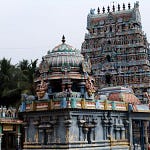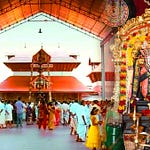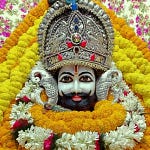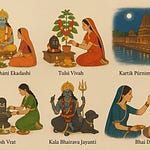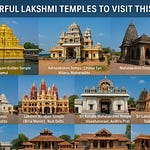Amidst the vibrant spiritual landscape of Gujarat lies Khodaldham, an awe-inspiring temple dedicated to Maa Khodiyar, the divine protector and kuldevi of the Leuva Patidar community. Located in the serene village of Kagvad, between Rajkot and Jetpur, this temple isn’t just a place of worship—it's a living embodiment of unity, heritage, and devotion.
Inaugurated in 2017, this architectural marvel is a testament to collective faith and spiritual vision. Built through the efforts and donations of millions, Khodaldham symbolizes not just religious sentiment, but also the cultural strength and unity of the Patidar community. With its towering shikhars, intricate stone carvings, and vast campus, it has become a beacon of faith and pride, drawing pilgrims, tourists, and spiritual seekers from across India and the world.
History and Origin
The roots of Khodaldham are deeply tied to Maa Khodiyar, the kuldevi (family deity) of the Leuva Patidar community. Maa Khodiyar is believed to be an incarnation of Shakti, the Divine Mother. According to legend, she emerged to protect her devotees and uphold dharma, riding a crocodile as her divine vehicle.
The idea of building a grand temple emerged from the community’s devotion and the desire to create a unifying spiritual center. The Khodaldham Trust, comprising over 75 trustees from various regions of Gujarat and abroad, took the initiative to create this magnificent spiritual hub.
The story of Khodaldham begins with the ancient legend of Maa Khodiyar, who is believed to have emerged during the 8th century to bless and protect her devotees. She is often depicted riding a mugger (crocodile), symbolizing her fearless and motherly nature.
The Leuva Patidar community, traditionally agriculturists, has revered her as their divine guardian for centuries. The dream of building a grand temple took form in the early 2010s when the Shree Khodaldham Trust decided to construct a monumental site that reflects their devotion, cultural roots, and aspirations for spiritual resurgence.
Foundation and Construction
The foundation stone of Khodaldham was laid on May 21, 2012, and the temple was inaugurated on January 21, 2017. The construction was led by Shree Khodaldham Trust (SKT). The temple was built with donations from the community, showcasing an incredible act of collective faith and unity.
The foundation stone was laid in 2012, and by January 2017, the temple was opened with a grand inauguration ceremony attended by lakhs of devotees and dignitaries.
Highlights of the Temple’s Architecture:
Constructed using Bansi Paharpur sandstone from Rajasthan
Covers an area of over 290 acres
The central idol of Maa Khodiyar is 27 feet tall, carved from a single black granite block
The temple includes 72 subsidiary shrines for various deities like Lord Shiva, Vishnu, Ganesha, Hanuman, and more
The central spire rises to a height of 135 feet, symbolizing spiritual ascent
Every stone and carving tells a story—of valor, tradition, and divine connection.
Puja and Rituals
Daily worship and rituals at Khodaldham are performed with traditional Vedic practices, including:
Daily Puja Schedule:
Mangala Aarti – Early morning (around 5:30 AM)
Shringar Aarti – After the goddess is adorned
Bhog Aarti – Midday offering
Sandhya Aarti – Evening (around 7:00 PM)
Shayan Aarti – Before the temple closes at night
Devotees can also perform abhishek (ritual bathing of the idol), archana (personal prayer), and sankalp pujas for special occasions.
Spiritual and Historical Significance
Maa Khodiyar is believed to bless devotees with protection, strength, and prosperity.
The temple is not just a religious center, but a cultural and educational hub, with activities promoting youth leadership, unity, and heritage.
It stands as a symbol of Leuva Patidar identity, cultural pride, and spiritual resilience.
The temple is open to all castes and communities, promoting inclusivity and harmony.
Festivals and Celebrations
Khodaldham hosts grand celebrations throughout the year, with Khodiyar Jayanti being the most prominent. During this time, lakhs gather to celebrate the divine mother’s birth with bhajans, cultural performances, and large-scale anna seva (community meals).
Khodiyar Jayanti – The most significant festival, celebrating the birth of Maa Khodiyar.
Navratri – The nine nights of devotion with garba, aarti, and bhajans.
Janmashtami, Diwali, and Makar Sankranti – Celebrated with grandeur and community feasts.
Mahashivratri – Special prayers and rituals for Lord Shiva.
Shakti Mahotsav – A grand annual festival organized by the Trust with spiritual discourses, kirtans, and cultural programs.
Aarti and Darshan Timings
Temple Opening: 5:00 AM
Mangala Aarti: 5:30 AM
Shringar Aarti: 8:00 AM
Bhog Aarti: 12:00 PM
Sandhya Aarti: 7:00 PM
Shayan Aarti: 8:30 PM
Temple Closes: 9:00 PM
Note: Timings may vary during festivals and special occasions.
Travel and Accessibility
How to Reach Khodaldham:
By Road:
Located on Rajkot–Jetpur highway, Khodaldham is short drive from Rajkot (~65 km).By Train:
Nearest railway station – Jetpur Junction (15 km)By Air:
Rajkot Airport is the closest, connected to major Indian cities.Ample parking and facilities are available for tourists and pilgrims.
Nearby Attractions
Make your spiritual trip even more meaningful by visiting these nearby places:
Jetpur City – Known for textiles and local cuisine
Gondal Palace – Royal heritage and architecture
Gir National Park – Famous for Asiatic lions (approx. 90 km)
Junagadh – Forts, caves, and Mount Girnar
Somnath Temple – One of the 12 Jyotirlingas (approx. 140 km)
Facilities at Khodaldham
Dining halls (Bhojanalaya) with free meals (Prasad)
Accommodation and guest houses
Museum & Cultural Gallery explaining Maa Khodiyar's legacy
Prayer and meditation halls
Bookstores, souvenir shops, and library
Tips for Devotees and Visitors
Dress modestly and respect the temple norms.
Avoid carrying leather items or non-vegetarian food.
Follow cleanliness and discipline during temple visits.
Participate in community meals (Anna Seva) – a heartwarming experience.
Early mornings and evenings offer a peaceful darshan experience.
Visiting Khodaldham is not just a pilgrimage—it’s an emotional, spiritual, and cultural journey. It is where faith meets grandeur, where unity resonates in every prayer, and where the spirit of Maa Khodiyar envelops every heart. Whether you're a staunch devotee, a spiritual explorer, or someone seeking inner peace, Khodaldham promises an experience that transcends rituals and touches the soul.
In today’s fast-paced world, this sacred temple offers a pause for reflection, gratitude, and connection—with the divine, with community, and with one’s higher self.
Video Source : @dhruvpfilms




